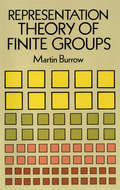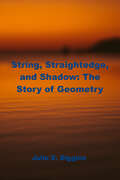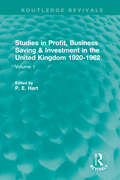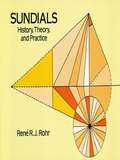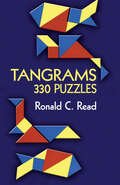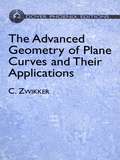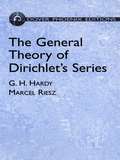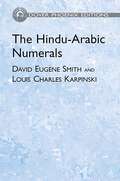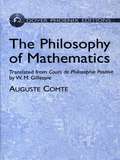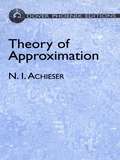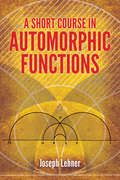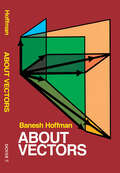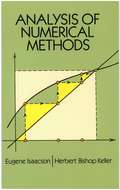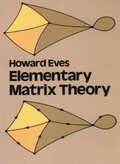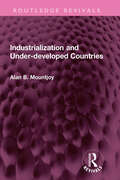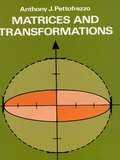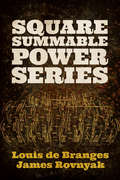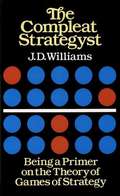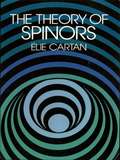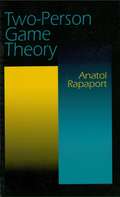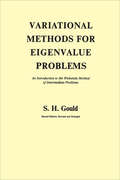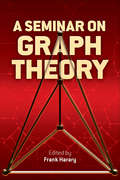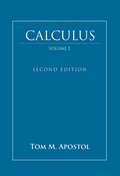- Table View
- List View
Representation Theory of Finite Groups
by Martin BurrowConcise, graduate-level exposition of the theory of finite groups, including the theory of modular representations. Topics include representation theory of rings with identity, representation theory of finite groups, applications of the theory of characters, construction of irreducible representations and modular representations. Rudiments of linear algebra and knowledge of group theory helpful prerequisites. Exercises. Bibliography. Appendix. 1965 edition.
String, Straightedge, and Shadow: The Story of Geometry
by Julia E. DigginsThis book explains how the basic principles of elementary geometry were discovered over 2,000 years ago. Indicates the major roles played by the early civilizations of Mesopotamia, Egypt, and Greece.
Studies in Profit, Business Saving and Investment in the United Kingdom 1920-1962: Volume 1 (Routledge Revivals)
by P. E. HartThe results of the 1959 Glasgow University investigation into British industrial profit, business saving, and investment are the subject of this book, originally published in 1965. Part 1 presents original estimates of profits in British industries 1920-1938, which when linked with Government estimates of such profits since 1948, permit long runs studies of the fortunes of individual industries. In addition, the appropriation of profit between dividends and business saving is also estimated for manufacturing industry 1920-1938. Part 2 begins the analysis of the extensive financial data collected in the Glasgow enquiry and is concerned with the effects of the size of a firm on its financial performance. The financial performance of large companies quoted on the Stock Exchange with a sample of small unquoted private companies and unincorporated firms is compared.
Sundials: History, Theory, and Practice
by René R.J. Rohr"His lively pen, his direct and simple style, his expressive vocabulary, his avoidance of pedantry, his conciseness in the exposition of his thoughts make his book a pleasure to read." -- Henri Michel, International Academy of the History of ScienceThe story of man's efforts to measure time is a long one -- reaching back thousands of years to the dawn of civilization. Among the earliest instruments developed for telling time was the sundial. In this expert study, a noted sundial expert offers a fascinating and informative account of these ancient devices, presented in simple, lively language.Over the centuries, many different varieties of sundials have been constructed, and Mr. Rohr provides detailed, accurate descriptions of them all: classical sundials, inclined dials, solar calendars, analemmatic dials, moon dials, and many more. There is even a chapter devoted to especially remarkable dials past and present, and a listing of the most popular sundial mottoes. In this profusely illustrated volume, you will not only learn about the long and colorful history of the sundial, you will learn a practical method of building one yourself. No special knowledge is required, other than an understanding of the basic principles of cosmography and of the relative movements of the sun and the planets. (These are recalled in an elementary way in a special chapter.) For mathematically inclined readers, more complex formulae and calculations have been included, some of which have never been printed in a book of gnomonics.
Tangrams: 330 Puzzles (Dover Recreational Math)
by Ronald C. ReadThis collection gathers together nearly 330 tangrams, the best creations of both Chinese and Occidental puzzle devisers. Included are puzzles carefully selected from rare 19th-century books and some of the most inventive and imaginative inventions of Loyd and Dudeney. Tangrams range from the relatively easy to the difficult.
The Advanced Geometry of Plane Curves and Their Applications (Dover Books on Mathematics)
by C. Zwikker"Of chief interest to mathematicians, but physicists and others will be fascinated ... and intrigued by the fruitful use of non-Cartesian methods. Students ... should find the book stimulating." -- British Journal of Applied PhysicsThis study of many important curves, their geometrical properties, and their applications features material not customarily treated in texts on synthetic or analytic Euclidean geometry. Its wide coverage, which includes both algebraic and transcendental curves, extends to unusual properties of familiar curves along with the nature of lesser known curves.Informative discussions of the line, circle, parabola, ellipse, and hyperbola presuppose only the most elementary facts. The less common curves -- cissoid, strophoid, spirals, the leminscate, cycloid, epicycloid, cardioid, and many others -- receive introductions that explain both their basic and advanced properties. Derived curves-the involute, evolute, pedal curve, envelope, and orthogonal trajectories-are also examined, with definitions of their important applications. These range through the fields of optics, electric circuit design, hydraulics, hydrodynamics, classical mechanics, electromagnetism, crystallography, gear design, road engineering, orbits of subatomic particles, and similar areas in physics and engineering. The author represents the points of the curves by complex numbers, rather than the real Cartesian coordinates, an approach that permits simple, direct, and elegant proofs.
The General Theory of Dirichlet's Series (Dover Books on Mathematics)
by G. H. Hardy Marcel RieszThis classic work explains the theory and formulas behind Dirichlet's series and offers the first systematic account of Riesz's theory of the summation of series by typical means. Its authors rank among the most distinguished mathematicians of the twentieth century: G. H. Hardy is famous for his achievements in number theory and mathematical analysis, and Marcel Riesz's interests ranged from functional analysis to partial differential equations, mathematical physics, number theory, and algebra.Following an introduction, the authors proceed to a discussion of the elementary theory of the convergence of Dirichlet's series, followed by a look at the formula for the sum of the coefficients of a Dirichlet's series in terms of the order of the function represented by the series. They continue with an examination of the summation of series by typical means and of general arithmetic theorems concerning typical means. After a survey of Abelian and Tauberian theorems and of further developments of the theory of functions represented by Dirichlet's series, the text concludes with an exploration of the multiplication of Dirichlet's series.
The Hindu-Arabic Numerals (Dover Books on Mathematics)
by David Eugene Smith Louis Charles KarpinskiThe numbers that we call Arabic are so familiar throughout Europe and the Americas that it can be difficult to realize that their general acceptance in commercial transactions is a matter of only the last four centuries and they still remain unknown in parts of the world.In this volume, one of the earliest texts to trace the origin and development of our number system, two distinguished mathematicians collaborated to bring together many fragmentary narrations to produce a concise history of Hindu-Arabic numerals. Clearly and succinctly, they recount the labors of scholars who have studied the subject in different parts of the world; they then assess the historical testimony and draw conclusions from its evidence. Topics include early ideas of the origin of numerals; Hindu forms with and without a place value; the symbol zero; the introduction of numbers into Europe by Boethius; the development of numerals among Arabic cultures; and the definitive introduction of numerals into Europe and their subsequent spread. Helpful supplements to the text include a guide to the pronunciation of Oriental names and an index.
The Philosophy of Mathematics: Translated from Cours de Philosophie Positive by W. M. Gillespie
by Auguste ComteWritten by the nineteenth-century French philosophical founder of positivism, this comprehensive map of mathematical science assigns to each part of the complex whole its true position and value. The two-part treatment begins with a general view of mathematical analysis and advances to algebra, continuing with an exploration of geometry's ancient and modern methods.
Theory of Approximation (Dover Books on Mathematics)
by N. I. AchieserA pioneer of many modern developments in approximation theory, N. I. Achieser designed this graduate-level text from the standpoint of functional analysis. The first two chapters address approximation problems in linear normalized spaces and the ideas of P. L. Tchebysheff. Chapter III examines the elements of harmonic analysis, and Chapter IV, integral transcendental functions of the exponential type. The final two chapters explore the best harmonic approximation of functions and Wiener's theorem on approximation. Professor Achieser concludes this exemplary text with an extensive section of problems and applications (elementary extremal problems, Szego's theorem, the Carathéodory-Fejér problem, and more).
A Short Course in Automorphic Functions (Dover Books on Mathematics)
by Joseph LehnerThis concise three-part treatment introduces undergraduate and graduate students to the theory of automorphic functions and discontinuous groups. Author Joseph Lehner begins by elaborating on the theory of discontinuous groups by the classical method of Poincaré, employing the model of the hyperbolic plane. The necessary hyperbolic geometry is developed in the text. Chapter two develops automorphic functions and forms via the Poincaré series. Formulas for divisors of a function and form are proved and their consequences analyzed. The final chapter is devoted to the connection between automorphic function theory and Riemann surface theory, concluding with some applications of Riemann-Roch theorem. <p> The book presupposes only the usual first courses in complex analysis, topology, and algebra. Exercises range from routine verifications to significant theorems. Notes at the end of each chapter describe further results and extensions, and a glossary offers definitions of terms.
About Vectors (Dover Books on Mathematics)
by Banesh HoffmannFrom his unusual beginning in "Defining a vector" to his final comments on "What then is a vector?" author Banesh Hoffmann has written a book that is provocative and unconventional. In his emphasis on the unresolved issue of defining a vector, Hoffmann mixes pure and applied mathematics without using calculus. The result is a treatment that can serve as a supplement and corrective to textbooks, as well as collateral reading in all courses that deal with vectors. Major topics include vectors and the parallelogram law; algebraic notation and basic ideas; vector algebra; scalars and scalar products; vector products and quotients of vectors; and tensors. The author writes with a fresh, challenging style, making all complex concepts readily understandable. Nearly 400 exercises appear throughout the text. Professor of Mathematics at Queens College at the City University of New York, Banesh Hoffmann is also the author of The Strange Story of the Quantum and other important books. This volume provides much that is new for both students and their instructors, and it will certainly generate debate and discussion in the classroom.
Analysis of Numerical Methods (Dover Books on Mathematics)
by Herbert Bishop Keller Eugene IsaacsonIn this age of omnipresent digital computers and their capacity for implementing numerical methods, no applied mathematician, physical scientist, or engineer can be considered properly trained without some understanding of those methods. This text, suitable for advanced undergraduate and graduate-level courses, supplies the required knowledge — not just by listing and describing methods, but by analyzing them carefully and stressing techniques for developing new methods.Based on each author's more than 40 years of experience in teaching university courses, this book offers lucid, carefully presented coverage of norms, numerical solution of linear systems and matrix factoring, iterative solutions of nonlinear equations, eigenvalues and eigenvectors, polynomial approximation, numerical solution of differential equations, and more. No mathematical preparation beyond advanced calculus and elementary linear algebra (or matrix theory) is assumed. Examples and problems are given that extend or amplify the analysis in many cases.
Elementary Matrix Theory (Dover Books on Mathematics)
by Howard EvesThe usefulness of matrix theory as a tool in disciplines ranging from quantum mechanics to psychometrics is widely recognized, and courses in matrix theory are increasingly a standard part of the undergraduate curriculum.This outstanding text offers an unusual introduction to matrix theory at the undergraduate level. Unlike most texts dealing with the topic, which tend to remain on an abstract level, Dr. Eves' book employs a concrete elementary approach, avoiding abstraction until the final chapter. This practical method renders the text especially accessible to students of physics, engineering, business and the social sciences, as well as math majors. Although the treatment is fundamental -- no previous courses in abstract algebra are required -- it is also flexible: each chapter includes special material for advanced students interested in deeper study or application of the theory.The book begins with preliminary remarks that set the stage for the author's concrete approach to matrix theory and the consideration of matrices as hypercomplex numbers. Dr. Eves then goes on to cover fundamental concepts and operations, equivalence, determinants, matrices with polynomial elements, similarity and congruence. A final optional chapter considers matrix theory from a generalized or abstract viewpoint, extending it to arbitrary number rings and fields, vector spaces and linear transformations of vector spaces. The author's concluding remarks direct the interested student to possible avenues of further study in matrix theory, while an extensive bibliography rounds out the book.Students of matrix theory will especially appreciate the many excellent problems (solutions not provided) included in each chapter, which are not just routine calculation exercises, but involve proof and extension of the concepts and material of the text. Scientists, engineers, economists and others whose work involves this important area of mathematics, will welcome the variety of special types of matrices and determinants discussed, which make the book not only a comprehensive introduction to the field, but a valuable resource and reference work.
Geography of South East Asia: தென்கிழக்கு ஆசியா
by G. Krishnamoorthyஇந்த தென்கிழக்கு ஆசிய புவியியல் புத்தகத்தில் தென்கிழக்கு ஆசியாவில் உள்ள மண்வளங்கள். கனிமங்கள், ஆறுகள், இயற்கை போன்றவற்றை பற்றி நாம் தெரிந்து கொள்வதற்கு நமக்கு பேரூதவியாக இருக்கிறது.
Industrialization and Under-developed Countries (Routledge Revivals)
by Alan B MountjoyFirst published in 1966, Industrialization and Under-Developed Countries traces the distribution, causes and problems of under-development and, from the point of view of the economic geographer, goes on to examine the difficulties and possibilities of industrialization as a remedy. Particular emphasis is laid upon the demographic factor both in the world situation and as affecting the way of life of individual countries. This book will be of interest to students of economics and geography.
Matrices and Transformations (Dover Books on Mathematics)
by Anthony J. PettofrezzoThis book presents an elementary and concrete approach to linear algebra that is both useful and essential for the beginning student and teacher of mathematics. Here are the fundamental concepts of matrix algebra, first in an intuitive framework and then in a more formal manner. A Variety of interpretations and applications of the elements and operations considered are included. In particular, the use of matrices in the study of transformations of the plane is stressed. The purpose of this book is to familiarize the reader with the role of matrices in abstract algebraic systems, and to illustrate its effective use as a mathematical tool in geometry. The first two chapters cover the basic concepts of matrix algebra that are important in the study of physics, statistics, economics, engineering, and mathematics. Matrices are considered as elements of an algebra. The concept of a linear transformation of the plane and the use of matrices in discussing such transformations are illustrated in Chapter #. Some aspects of the algebra of transformations and its relation to the algebra of matrices are included here. The last chapter on eigenvalues and eigenvectors contains material usually not found in an introductory treatment of matrix algebra, including an application of the properties of eigenvalues and eigenvectors to the study of the conics. Considerable attention has been paid throughout to the formulation of precise definitions and statements of theorems. The proofs of most of the theorems are included in detail in this book. Matrices and Transformations assumes only that the reader has some understanding of the basic fundamentals of vector algebra. Pettofrezzo gives numerous illustrative examples, practical applications, and intuitive analogies. There are many instructive exercises with answers to the odd-numbered questions at the back. The exercises range from routine computations to proofs of theorems that extend the theory of the subject. Originally written for a series concerned with the mathematical training of teachers, and tested with hundreds of college students, this book can be used as a class or supplementary text for enrichments programs at the high school level, a one-semester college course, individual study, or for in-service programs.
Prelude to Civil War: 1816-1836
by William W. FreehlingFrom the preface: "My reasons for presenting a re-examination of the Nullification Controversy go beyond a desire to clarify its causes. The crisis of 1832-3 is one of the more dramatic events in United States history, and has, I think, never been chronicled fully or accurately. Furthermore, the Nullification Crisis has usually been presented as an isolated event. Viewed in proper perspective, the confrontation between Andrew Jackson and the Carolina nullifiers was the central occurrence in the broader transition of South Carolina from the enthusiastic nationalism of 1816 to the extreme sectionalism of 1836. And I hope the following analysis of the acute anxieties surrounding the mere discussion of slavery during these years of transition will help to explain why South Carolina led the South in a suicidal assault on the federal Union a generation later."
Square Summable Power Series (Dover Books on Mathematics)
by James Rovnyak Louis De BrangesThis text for advanced undergraduate and graduate students introduces Hilbert space and analytic function theory, which is centered around the invariant subspace concept. The book's principal feature is the extensive use of formal power series methods to obtain and sometimes reformulate results of analytic function theory. The presentation is elementary in that it requires little previous knowledge of analysis, but it is designed to lead students to an advanced level of performance. This is achieved chiefly through the use of problems, many of which were proposed by former students. The book's tried-and-true approach was developed from the authors' lecture notes on courses taught at Lafayette College, Bryn Mawr College, and Purdue University.
The Compleat Strategyst: Being a Primer on the Theory of Games of Strategy
by J. D. WilliamsWhen J. D. Williams wrote this entertaining, witty introduction for the nonscientist, game theory was still a somewhat mysterious subject familiar to very few scientists beyond those researchers, like himself, working for the military. Now, over thirty years after its original publication as a Rand Corporation research study, his light-hearted though thoroughly effective primer is the recognized classic introduction to an increasingly applicable discipline. Used by amateurs, professionals, and students throughout the world in the classroom, on the job, and for personal amusement, the book has been through ten printings, and has been translated into at least five languages (including Russian and Japanese).Revised, updated, and available for the first time in an inexpensive paperback edition, The Compleat Strategyst is a highly entertaining text essential for anyone interested in this provocative and engaging area of modern mathematics. In fully illustrated chapters complete with everyday examples and word problems, Williams offers readers a working understanding of the possible methods for selecting strategies in a variety of situations, simple to complex. With just a basic understanding of arithmetic, anyone can grasp all necessary aspects of two-, three-, four-, and larger strategy games with two or more sets of inimical interests and a limitless array of zero-sum payoffs.As research and study continues not only in this new discipline but in the related areas of statistics, probability and behavioral science, understanding of games, decision making, and the development of strategies will be increasingly important. In the areas of economics, sociology, politics, and the military, game theory is sure to have an even wider impact. For students and amateurs fascinated by game theory's implications there is no better, immediately applicable, or more entertaining introduction to the subject than this engaging text by the late J. D. Williams, Professor of Mathematics at Princeton University and a member of the Research Council of The Rand Corporation.
The Theory of Spinors
by Élie CartanThe French mathematician Élie Cartan (1869-1951) was one of the founders of the modern theory of Lie groups, a subject of central importance in mathematics and also one with many applications. In this volume, he describes the orthogonal groups, either with real or complex parameters including reflections, and also the related groups with indefinite metrics. He develops the theory of spinors (he discovered the general mathematical form of spinors in 1913) systematically by giving a purely geometrical definition of these mathematical entities; this geometrical origin makes it very easy to introduce spinors into Riemannian geometry, and particularly to apply the idea of parallel transport to these geometrical entities.The book is divided into two parts. The first is devoted to generalities on the group of rotations in n-dimensional space and on the linear representations of groups, and to the theory of spinors in three-dimensional space. Finally, the linear representations of the group of rotations in that space (of particular importance to quantum mechanics) are also examined. The second part is devoted to the theory of spinors in spaces of any number of dimensions, and particularly in the space of special relativity (Minkowski space). While the basic orientation of the book as a whole is mathematical, physicists will be especially interested in the final chapters treating the applications of spinors in the rotation and Lorentz groups. In this connection, Cartan shows how to derive the "Dirac" equation for any group, and extends the equation to general relativity.One of the greatest mathematicians of the 20th century, Cartan made notable contributions in mathematical physics, differential geometry, and group theory. Although a profound theorist, he was able to explain difficult concepts with clarity and simplicity. In this detailed, explicit treatise, mathematicians specializing in quantum mechanics will find his lucid approach a great value.
Two-Person Game Theory
by Anatol Rapoport"Game theory is an intellectual X-ray. It reveals the skeletal structure of those systems where decisions interact, and it reveals, therefore, the essential structure of both conflict and cooperation." -- Kenneth BouldingThis fascinating and provocative book presents the fundamentals of two-person game theory, a mathematical approach to understanding human behavior and decision-making, Developed from analysis of games of strategy such as chess, checkers, and Go, game theory has dramatic applications to the entire realm of human events, from politics, economics, and war, to environmental issues, business, social relationships, and even "the game of love." Typically, game theory deals with decisions in conflict situations.Written by a noted expert in the field, this clear, non-technical volume introduces the theory of games in a way which brings the essentials into focus and keeps them there. In addition to lucid discussions of such standard topics as utilities, strategy, the game tree, and the game matrix, dominating strategy and minimax, negotiated and nonnegotiable games, and solving the two-person zero-sum game, the author includes a discussion of gaming theory, an important link between abstract game theory and an experimentally oriented behavioral science. Specific applications to social science have not been stressed, but the methodological relations between game theory, decision theory, and social science are emphasized throughout.Although game theory employs a mathematical approach to conflict resolution, the present volume avoids all but the minimum of mathematical notation. Moreover, the reader will find only the mathematics of high school algebra and of very elementary analytic geometry, except for an occasional derivative. The result is an accessible, easy-to-follow treatment that will be welcomed by mathematicians and non-mathematicians alike.
Variational Methods for Eigenvalue Problems: An Introduction to the Weinstein Method of Intermediate Problems (Second Edition) (Mathematical Expositions #10)
by S. H. GouldThe first edition of this book gave a systematic exposition of the Weinstein method of calculating lower bounds of eigenvalues by means of intermediate problems. From the reviews of this edition and from subsequent shorter expositions it has become clear that the method is of considerable interest to the mathematical world; this interest has increased greatly in recent years by the success of some mathematicians in simplifying and extending the numerical applications, particularly in quantum mechanics. Until now new developments have been available only in articles scattered throughout the literature: this second edition presents them systematically in the framework of the material contained in the first edition, which is retained in somewhat modified form.
A Seminar on Graph Theory (Dover Books on Mathematics)
by Frank HararyPresented in 1962–63 by experts at University College, London, these lectures offer a variety of perspectives on graph theory. Although the opening chapters form a coherent body of graph theoretic concepts, this volume is not a text on the subject but rather an introduction to the extensive literature of graph theory. The seminar's topics are geared toward advanced undergraduate students of mathematics.Lectures by this volume's editor, Frank Harary, include "Some Theorems and Concepts of Graph Theory," "Topological Concepts in Graph Theory," "Graphical Reconstruction," and other introductory talks. A series of invited lectures follows, featuring presentations by other authorities on the faculty of University College as well as visiting scholars. These include "Extremal Problems in Graph Theory" by Paul Erdös, "Complete Bipartite Graphs: Decomposition into Planar Subgraphs," by Lowell W. Beineke, "Graphs and Composite Games," by Cedric A. B. Smith, and several others.
Calculus, Volume 1
by Tom M. ApostolAn introduction to the Calculus, with an excellent balance between theory and technique. Integration is treated before differentiation--this is a departure from most modern texts, but it is historically correct, and it is the best way to establish the true connection between the integral and the derivative. Proofs of all the important theorems are given, generally preceded by geometric or intuitive discussion. This Second Edition introduces the mean-value theorems and their applications earlier in the text, incorporates a treatment of linear algebra, and contains many new and easier exercises. As in the first edition, an interesting historical introduction precedes each important new concept.
